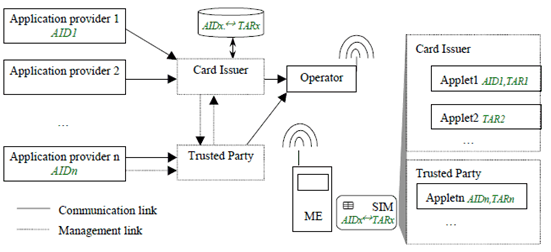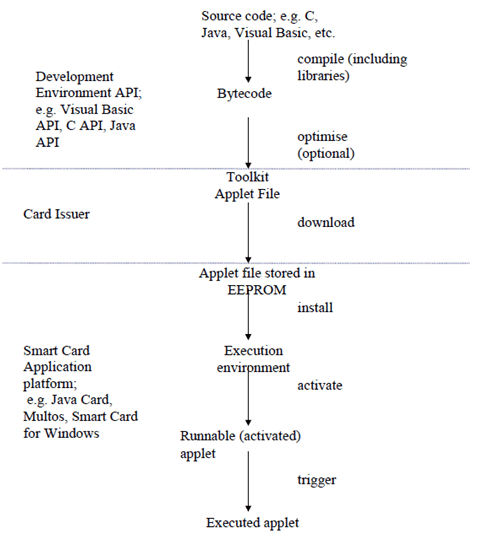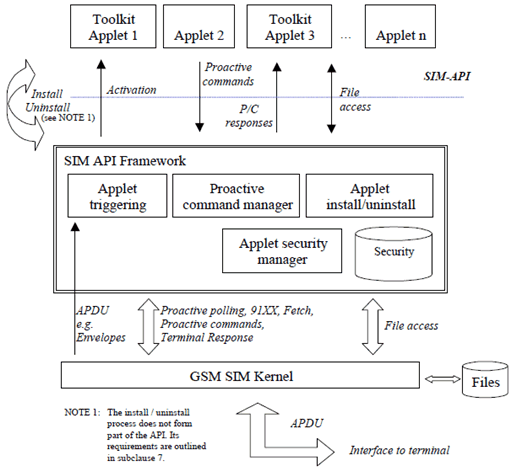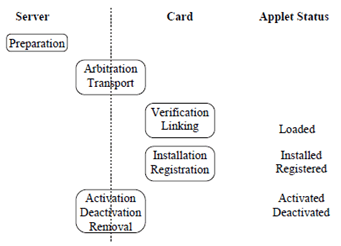TS 42.019
SIM API
V5.1.0 (PDF)
2005/06 20 p.
V4.1.0
2005/06 20 p.
GSM Rel-99 v8.1.0
2005/06 20 p.
GSM Rel-98 v7.1.0
1999/06 19 p.
- Rapporteur:
- Mr. Hans, Sebastian
Content for TS 42.019 Word version: 5.1.0
1 Scope Word‑p. 6
The present document defines the stage one description of the Subscriber Identity Module Application Programming Interface (SIM API) internal to the SIM. Stage one is an overall service description, and does not deal with the implementation details of the API.
The present document includes information applicable to network operators, service providers and terminal, SIM, switch and database manufacturers.
The present document contains the core requirements which are sufficient to provide a complete service.
It is highly desirable however, that technical solutions for a SIM API should be sufficiently flexible to allow for possible enhancements. Additional functionalities not documented in the present document may implement requirements which are considered outside the scope of the present document. This additional functionality may be on a network-wide basis, nation-wide basis or particular to a group of users. Such additional functionality shall not compromise conformance to the core requirements of the service.
2 References Word‑p. 6
The following documents contain provisions which, through reference in this text, constitute provisions of the present document.
- References are either specific (identified by date of publication, edition number, version number, etc.) or non specific.
- For a specific reference, subsequent revisions do not apply.
- For a non-specific reference, the latest version applies. In the case of a reference to a 3GPP document (including a GSM document), a non-specific reference implicitly refers to the latest version of that document in the same Release as the present document.
[1]
TR 21.905: "Vocabulary for 3GPP Specifications".
[2]
TS 51.011: "Specification of the Subscriber Identity Module - Mobile Equipment (SIM - ME) interface".
[3]
GSM TS 11.14: "Specification of the SIM Application Toolkit for the Subscriber Identity Module - Mobile Equipment (SIM - ME) interface".
[4]
TS 23.048: "Security Mechanisms for the SIM application toolkit; Stage 2".
[5]
ISO/IEC 7816-3:1997: "Identification cards Integrated circuit(s) cards with contacts, Part 3: Electronic signals and transmission protocols".
[6]
ISO/IEC 7816-4: "Identification cards - Integrated circuit cards Part 4: Organization, security and commands for interchange".
3 Definitions and abbreviations Word‑p. 6
3.1 Definitions Word‑p. 6
For the purposes of the present document, the following terms and definitions apply.
Applet:
An Applet is an application built up using a number of modules which will run under the control of a virtual machine.
Bytecode:
Machine independent code generated by a bytecode compiler and executed by a bytecode interpreter.
Data Structure:
A collection of related data values such as the age, birth date and height of an individual.
Framework:
A framework defines a set of Application Programming Interface (API) functions and data structures for developing applications and for providing system services to those applications.
Function:
A callable and executable body of computer instructions which perform a specific computation or data processing task.
GSM applet:
The GSM application conforming to TS 51.011.
Module:
A collection of functions and data structures which implement an entire application or a particular application feature or capability.
SIM API Framework:
Part of the SIM responsible for the handling of applications (including triggering and loading). It also contains the library for the proactive API.
Toolkit applet:
Applet loaded onto the SIM seen by the mobile as being part of the SIM Toolkit application and containing only the code necessary to run the application. These applets might be downloaded over the radio interface.
Trusted Party:
A trusted party can be described as an entity trusted by the card issuer with respect to security-related services and activities.
Virtual Machine:
The part of the Run-time environment responsible for interpreting the bytecode.
3.2 Abbreviations Word‑p. 7
For the purposes of the present document, the following abbreviations apply:
AC
Application Code
AID
Applet IDentifier
APDU
Application Protocol Data Unit
API
Application Programming Interface
AVN
Applet Version Number
CA
Certification Authority
CAD
Card Acceptance Device
CHV1/2
Card Holder Verification information 1 and 2
EEPROM
Electrically Erasable and Programmable Read Only Memory
EPOS
Electronic Point of Sale
FFS
For Further Study
GPRS
General Packet Radio Service
IFD
Interface Device
IN
Intelligent Network
ME
Mobile Equipment
MExE
Mobile Station Execution Environment
MS
Mobile Station
RAM
Random Access Memory
ROM
Read Only Memory
RPC
Remote Procedure Call
SIM
Subscriber Identity Module
SE
Sending Entity
SMS-CB
Short Message Service - Cell Broadcast
SMS P-P
Short Message Service, Point to Point
TAR
Toolkit Application Reference
TLV
Tag, Length, Value
USSD
Unstructured Supplementary Services Data
WAP
Wireless Application Protocol
WTLS
WAP Transport Layer Security
4 Description Word‑p. 8
This document describes the high level requirements for an API for the GSM SIM. This API shall allow application programmers easy access to the functions and data described in TS 51.011 and GSM 11.14 [3], such that SIM based services can be developed and loaded onto SIMs, quickly and, if necessarily, remotely, after the card has been issued.

4.1 Design of SIM based applications using the SIM API Word‑p. 8
Figure 2 shows how SIM applications can be developed in a standard development environment and converted into an interpreted format, then loaded into the card.

4.2 SIM API Architecture Word‑p. 10
The SIM API shall consist of APIs for GSM 11.14 [3] (pro-active functions) and TS 51.011 (transport functions). Figure 3 illustrates the interactions between these APIs.

In this model, the GSM data field structure is viewed as a series of data structures and data access functions to the API. In the physical model of course, they may still be stored in elementary files, but the functions will access these data as values within those data structures.
The following Figure mirrors the SIM API architecture, relating each part to the appropriate GSM or ISO/IEC specification.

A general requirement of the SIM API is that applets should not interfere with the basic GSM services.
The SIM API framework shall prevent the toolkit applets from sending proactive commands which would interfere with the correct execution of the card operating system and/or other toolkit applets.
4.3 GSM file data access Word‑p. 11
The following methods shall be offered by the SIM Toolkit API:
Select File:
Select a file without changing the current file of any other applet or of the subscriber session. At the beginning of an entry point of an applet, the current file is the MF. This function may return the selected file information;
Status:
Read the file status information of the current DF;
Read Binary:
Read data bytes of a transparent EF;
Read Record:
Read data bytes of a linear fixed or cyclic EF without changing the current record pointer of any other applet / subscriber. This function may allow reading part of a record;
Update Binary:
Modify data bytes to a transparent EF;
Update Record:
Modify data bytes to a linear fixed or cyclic EF. The current record pointer of other applets / subscriber shall not be changed in case of linear fixed EF but the current record of a cyclic EF shall be changed for all other applets / subscriber. This function may allow updating part of a record;
Seek:
Search a record of a linear fixed file starting with a given pattern. The current record pointer of any other applet or of the subscriber session shall not be changed;
Increase:
Increase the value of the current record of a cyclic EF. The current record will be changed for every other applet and subscriber session. This function may not return the increased value;
Rehabilitate:
Rehabilitate the current EF with effect for all other applets / subscriber;
Invalidate:
Invalidate the current EF with effect for all other applets / subscriber.
5 Card Interoperability Word‑p. 11
5.1 Loader Requirements Word‑p. 11
There are a number of requirements for the loader which are seen as being vital to the successful deployment of SIM API based SIMs
- The Applet format shall be common to all compliant SIMs, such that a card issuer can deploy SIM API based service applets to any SIM API compliant SIM.
-
The loader environment that allows the loading of applets to the SIM shall be common to all SIM API compliant SIMs. This loader shall be able to send applets to SIMs in three distinct ways:
- During the personalization of the SIM, prior to the issue of the SIM to the user.
- During the life of the SIM using the SIM Data Download mechanism defined in TS 51.011 and TS 23.048 or using other standardized mechanisms in the future.
- During the life of the SIM using an IFD (Interface Device) or CAD (Card Accepting Device, e.g. an EPOS terminal).
5.2 Application Transport Word‑p. 11
The transport of applications shall be transparent to the ME. Applications may be transported via several different bearers, e.g. SMS P-P, SMS-CB, USSD, GPRS etc. Transportation of applications to the SIM in a Phase 2+ SIM Application ME shall use the ENVELOPE command as specified in TS 51.011.
Other standardized transport commands to the SIM may be developed in the future. Transport commands other than ENVELOPE may be used to transport applets to the SIM if the SIM is not in an ME.
6 Applet triggering Word‑p. 12
The application triggering portion of the SIM API Framework is responsible for the activation of applets, based on the APDU received by the GSM application. The inputs and outputs could be represented in the Figure below :

Entry points to the applet shall be provided in two ways:
- High level entry points, in order to have a simple programming of the SIM card
- Low level entry points to support the evolution of the GSM 11.14 [3] specification (see clause 10.2)
- Application Loading
- Application Removal
- Terminal Profile
- Menu Selection
- Short Message Reception
- Cell Broadcast Short Message Reception
- Call Control
7 Applet Life cycle management Word‑p. 12
The applet life cycle management concerns the applet preparation, loading, installation, registration, configuration, execution and removal/deactivation.

7.1 Applet Preparation Word‑p. 13
"Applet Preparation" refers to the optional phase of verifying the compliance of the applet code with card issuer standards.
The applet is to be identified through an Applet Identification Number (AID) which is assigned through the procedure detailed in ISO/IEC 7816-4 [6] and an Applet Version Number (AVN). Both AID and AVN are assigned during the applet preparation phase.
The minimum requirements for the applet (such as API versions, SIM capabilities, resource requirements) shall be specified.
7.2 Loading Word‑p. 13
"Loading" refers to the process of transporting the applet code from a load server to the SIM and generating the loaded code on the SIM.
The process shall be under the principle control of the card issuer, who may choose to delegate this responsibility to one or more trusted parties, possibly while imposing resource restrictions (e.g. maximum memory allowance) or access restrictions (e.g. limited or reduced functionality).
The loading process involves four distinct phases: Arbitration, Transport, Verification and Linking. The card shall provide acknowledgement of success or failure (including error identification code) to the load server if the load server requires this.
7.2.1 Arbitration Word‑p. 13
This phase is accomplished by mutual authentication between the SIM and the load server, and by establishing appropriate session keys for ensuring security during the data transfer, which is to follow.
The minimum applet requirements are verified with regard to the environment present on the SIM (e.g. API version, SIM capabilities and available memory). If this fails, the loading process shall be aborted.
The applet identifiers (AIDs) and version numbers (AVNs) of any applets already installed on the SIM are compared to the AID and AVN of the applet, which is to be downloaded. If an identical applet is already installed on the SIM (i.e. both applet identifier and version number match), the phases Transport, Verification and Linking are skipped. If an applet with an identical applet identifier (AID) but different version number (AVN) is available on the SIM, that applet is removed (see subclause 7.7, Removal).
7.2.2 Transport Word‑p. 13
This stage shall encompass the transport of the data packets from the load server to the SIM, and may be done in accordance with TS 23.048 and optionally additional encryption using session keys generated/exchanged during the Arbitration phase.
7.2.3 Verification Word‑p. 13
This stage shall encompass the verification of the received data and may involved byte-code level or applet-specific verification. Should the verification stage fail, the applet shall be discarded.
7.2.4 Linking Word‑p. 13
This stage shall encompass the linking of the received code against the runtime environment present on the card.
7.3 Installation/Registration/Reactivation Word‑p. 13
This stage refers to the execution of applet-code regarding to the installation and registration of the applet with respect to the SIM/ME runtime environment. For example, this may involve the generation of an applet-specific menu entry in the ME's user interface through the appropriate SIM toolkit command, and the generation of applet-specific data structures in SIM memory.
If the applet already exists on the SIM and is deactivated (see subclause 7.6), the installation request shall reactivate the applet. Other methods of reactivation are possible via a separate command.
7.4 Configuration Word‑p. 14
This stage may involve any necessary configuration of the applet code with regard to a particular user/set-up/environment. This stage is driven through code provided with the applet itself and may be executed repeatedly.
7.5 Execution Word‑p. 14
At this stage, providing the applet is activated, the applet is in a state where its execution may be triggered by any event as specified in clause 6.
7.6 Deactivation Word‑p. 14
This stage involves disabling the ability to execute applet code in the SIM and may be triggered by the user, the network operator or any third party, providing sufficient access rights are granted to them. Deactivation may include the release of any applet reserved resources (e.g. memory resources etc.).
7.7 Removal Word‑p. 14
This stage follows the deactivation of the applet and prevents the applet's reactivation. This may be followed by the release of the applet's memory. For security reasons, the memory may be overwritten by null data.
8 Security management Word‑p. 14
8.1 Management of Applets Word‑p. 14
Security might be required during the loading of the applet from a load server onto the SIM, and the communications between the applet and any remote server during the execution of the applet code. In both cases security may involve the authentication of the communicating entities and the encryption of the data traffic between those entities.
A hierarchy of keys may be bootstrapped by initializing a set of keys by the card issuer during card personalization. Additional keys may be generated, distributed using existing keys, and equipped with limited authority. Such keys may be passed on to trusted parties and subsequently used for authentication and encryption.
8.2 Applet Certification Word‑p. 14
The role of certification is to ensure that only the authorized entities are able to download an application on to the SIM. Based on this certificate, the card shall decide whether or not to accept the downloaded application.
9 API Compatibility Word‑p. 14
9.1 Level of Compatibility Word‑p. 14
The commands and features supported by the API shall be as specified in the same Release year of TS 51.011 and GSM 11.14 [3].
9.2 Compatibility at the Interface Word‑p. 15
In order to provide compatibility with the SIM/ME interface, a GSM application SIM implemented using the SIM API shall provide full functional compatibility with the structure and content of TS 51.011, GSM 11.14 [3] commands as specified in those documents. SIM implementing the API shall be compatible with all phases of MEs.
9.3 Compatibility at the programming interface Word‑p. 15
All commands (at the functional level) shall be presented in a manner consistent with the customary or recommended use of the programming language at the programming level.
The SIM API shall be provided in two ways:
- an easy to use high level interface (proactive commands level), and
- a low level interface (i.e. the TLV parameters) to maximise scope without the need to extend the SIM API.
9.4 Compatibility with other specifications Word‑p. 15
[TBD e.g. MExE and WAP]
10 API Extensibility Word‑p. 15
The SIM API shall support applications written for previous versions of the SIM API.
There shall be means to manage versions of the SIM API.
At installation of an applet the required SIM API version shall be checked as described in clause 7.
The ability to extend the SIM API to add functionality may be possible without reissuing the card.
10.1 Evolution of SIM / ME Interface (TS 51.011) Word‑p. 15
As the SIM/ME interface is handled by the GSM SIM kernel any evolution of the interface may require the introduction of a new SIM API version.
Older version of the SIM API would still be allowable, but would not have access to the interface enhancement.
10.2 Evolution of SIM Application Toolkit (TS 11.14) Word‑p. 15
The SIM API shall provide a low-level interface to support any further releases of GSM 11.14 [3].
A new version of the SIM API shall provide support for the new features at a high level interface.
10.3 Interworking with other systems Word‑p. 15
If interworking at APDU and SIM API level with other systems (e.g. MExE, WAP) require some specific functionality, it will first need to be defined either in the TS 51.011 or GSM 11.14 [3], and as a result it will be taken into account in the API specification.
[Administrative command support is currently under discussion within 3GPP TSG-T WG3]
11 Data and Function Sharing and Access Control Word‑p. 16
11.1 Sharing resources between applets Word‑p. 16
The API shall provide a secure data structure and function sharing mechanism between applets and with the GSM SIM kernel.
The GSM SIM kernel should be able to share with applets:
- GSM files : to get file status, read and update data field
- CHV1,CHV2 : to get status.
- high: GSM SIM kernel data sharing (e.g. access to the Telecom directory),
- medium: inter industry sharing mechanism between applets.
11.2 Access to data Word‑p. 16
The SIM API shall provide a way to let each applet indicate:
- the shared data and functions,
- the associated access functions to these data and functions,
- the security or trust level required,
- the accepted certification authorities, and,
- the identity of the applet provider.
12 Technology Considerations Word‑p. 16
12.1 SIM hardware requirements Word‑p. 16
The SIM API requires a smart card device that is capable of implementing a virtual machine and the SIM API framework. It is seen as necessary that there is sufficient EEPROM to contain SIM Applets (either SIM toolkit applications or other SIM applications) along side the mandatory GSM files and potentially many (if not all) of the optional GSM files. The hardware requirements are likely to be:
- ROM: minimum 24K Bytes
- RAM: minimum 1K Byte
- EEPROM: minimum 16K Bytes
12.2 Technology limitations Word‑p. 16
12.2.1 Memory Recovery Word‑p. 16
Although there is a requirement for SIM API compliant devices to allow reconfiguration, termination and removal of Applets, it is recognised that SIM API devices may not be fully capable of reclaiming the memory freed up.
12.3 Evolution Word‑p. 17
12.3.1 Remote Procedure Call Word‑p. 17
Some current technologies that meet the needs of the SIM API are not designed to allow RPC. Future alternative technologies may be able to support this. It is seen as a future requirement of SIM API when interacting with mobile equipment technologies such as MExE and WAP that RPC is supported.